Well in the country: where to dig, how to strengthen, how to arrange
For many city dwellers, the well has already become something archaic, even the subject of folklore, with which many legends, tales and signs are associated. But the well continues to be a reliable source of autonomous water supply. Its presence is necessary even in those areas where there is a central water supply, it’s just that the well has already become a real attribute of suburban and country life. Compared to wells, this is a very simple structure, which has its advantages: fresh water can be obtained from there, even if there is no electricity, which is so necessary for the pump to work in the wells. But the arrangement of the well, despite its relative simplicity, also requires compliance with certain rules and requirements.
Where to dig a well in the country?
Perhaps the first question, if you want to equip a well on your territory, is the question of where is it better to dig itin order to obtain water of the required quality and in the required quantity in order to fit the future construction into site landscape design etc.
There are a number of ways to find on your site the very place where the well should be located:
 Scientific. It is best to invite professional hydrogeologists who will explore the area, conduct exploratory drilling, analyze many factors, and ultimately provide the most complete picture. They will tell not only about where it is better to place the well, but they will tell you which type is better to choose, how best to build and strengthen, and how much it will cost. A professional should also analyze the quality of groundwater and identify the influence of external factors on them, and even advise how best to fit such a simple engineering structure into the landscape. When choosing a place for a well, factors such as the height of the territory, the location of nearby dangerous places, etc. are taken into account. So, if you dig a well in the low part of the site, then the cost of the work will be low, but it is likely that water will get into the water from melting snow, rain, etc., the high-altitude parts of the site are more protected, but the place where it lies is optimal interstratal waters. It is better to dig a well at the maximum distance from possible pollution: landfills, drain pits, pools, baths, etc., and the reconnaissance process should be carried out in dry weather. All this and not only the hydrogeologist should know, who will determine the best place for the location of the well as accurately as possible.
Scientific. It is best to invite professional hydrogeologists who will explore the area, conduct exploratory drilling, analyze many factors, and ultimately provide the most complete picture. They will tell not only about where it is better to place the well, but they will tell you which type is better to choose, how best to build and strengthen, and how much it will cost. A professional should also analyze the quality of groundwater and identify the influence of external factors on them, and even advise how best to fit such a simple engineering structure into the landscape. When choosing a place for a well, factors such as the height of the territory, the location of nearby dangerous places, etc. are taken into account. So, if you dig a well in the low part of the site, then the cost of the work will be low, but it is likely that water will get into the water from melting snow, rain, etc., the high-altitude parts of the site are more protected, but the place where it lies is optimal interstratal waters. It is better to dig a well at the maximum distance from possible pollution: landfills, drain pits, pools, baths, etc., and the reconnaissance process should be carried out in dry weather. All this and not only the hydrogeologist should know, who will determine the best place for the location of the well as accurately as possible.- A popular folk way is dowsing. Explanations of the nature of this method have not yet been given, but, nevertheless, it gives stably correct results. The easiest option is to use a sprig of viburnum, willow or hazel, while it should have a V-shape and an angle of at least 150 degrees. The branch is picked up at the two ends and slowly walks around the site with it, observing the behavior. In the place where the branch bends to the ground, most likely, there is water. A more modern method is the use of aluminum frames. Aluminum wire up to 1 m long is bent at a right angle so that the end length is 10-15 cm, it is better to insert it into a tube made of wood elderberry. Holding in their hands these frames, rotated 180 degrees apart, slowly walk around the site, and see where these frames unfold to each other - in this place there is water. Turning them simultaneously to one of the sides is a sign of the direction of water flow in a certain place.The point of contact of the two wires will indicate the place where you need to dig a well. In most cases, this method works, and if the branch does not fall or the frames do not touch, then you need to look for water in another place.
- Bioindication - Another way to find water on the site, you just have to take a closer look at the flora and fauna. There are some types of plants that adore moisture and grow only in places where groundwater is shallow. Such plants include willow, coltsfoot, sedge, reeds, nettles, digitalis, horse sorrel, evening fog, etc. If their foliage has a deep green color, then the water definitely lies shallow. Aquifer is also indicated by pillars. midges, the abundance of mosquitoes, but a large number of anthills and the presence of red ants they say that it’s better not to look for water here. Apple trees, cherries, plums will not grow on too wet soil, so if they are sick and dry, then most likely there is water under them, and it is in this place that you can try to equip a well.

- Other methods also relate to unscientific and based observations. So, if you turn the jar or glass over, then dew may appear on it if there is shallow water present underground. In the morning, fog spreads low over such places, in winter there are thawed snow, and in dry weather salt may get slightly wet. All these signs, together with the ones described above, will help you more or less accurately determine the location for the well in the area, but nevertheless the hydrogeological study will do this with one hundred percent accuracy, while at the same time giving information about the quality and depth of the water.
When choosing a place for a well, one must also take into account that the distance from it to toilets, landfills, and places for keeping animals should be at least 30 meters. It is necessary to take into account those buildings that may appear in the summer cottage in the future, as well as the location of the personal house, because the well for ease of use should be located as close to the house as possible.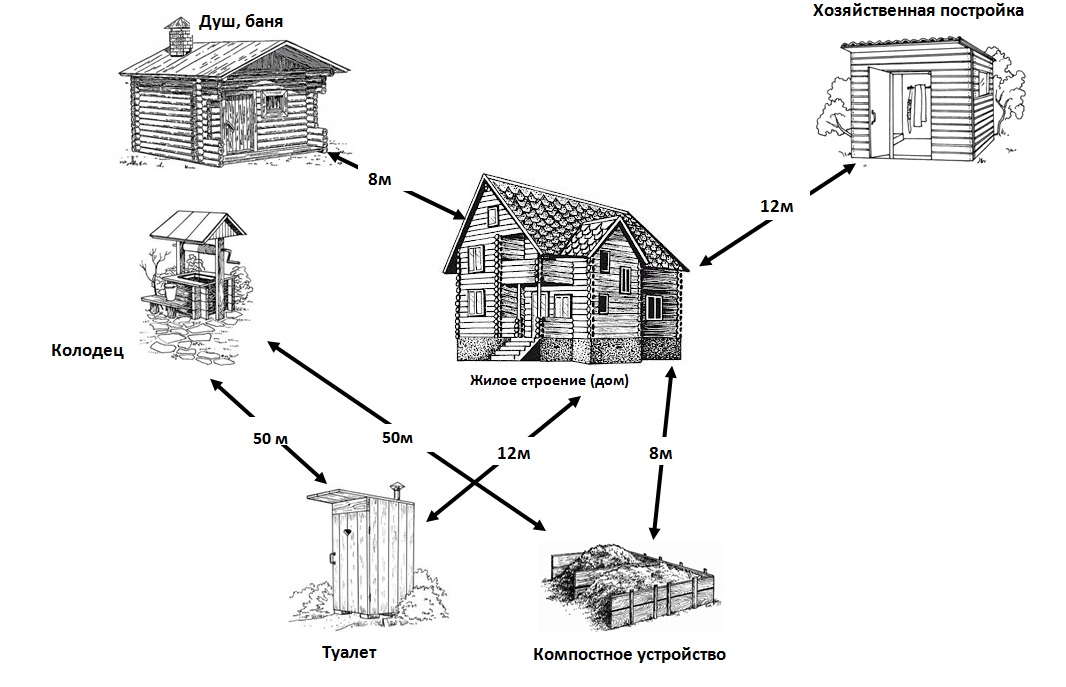
How to strengthen a well
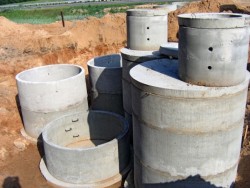 When the place for the well is determined, proceed to its immediate arrangement, which begins with digging. Here you can rely on your own strengths, you can hire a team of assistants, or you can use the mechanized method. In any case, the result is a deep shaft of a round or square shape, which rests on groundwater, suitable in composition for human use. The depth of the well in each case is different, which depends on many factors, but on average it is 5-10 meters, and only in some cases it can reach 25-30 meters.
When the place for the well is determined, proceed to its immediate arrangement, which begins with digging. Here you can rely on your own strengths, you can hire a team of assistants, or you can use the mechanized method. In any case, the result is a deep shaft of a round or square shape, which rests on groundwater, suitable in composition for human use. The depth of the well in each case is different, which depends on many factors, but on average it is 5-10 meters, and only in some cases it can reach 25-30 meters.
The design of the well consists of a head - this is the aboveground part, the mines - this is the base of the well, its longest part, and the water intake - this is the place where groundwater accumulates. Well bottom it is imperative to provide a filter for water treatment, which usually consists of several layers of gravel and crushed stone, the fraction size of which increases from top to bottom. If the soil is viscous, then before the arrangement of the filter, a wooden floor is also laid.
The well shaft may be made of stone, brickstree or concretebut today most often use ready concrete rings. At the same time, the reliability of the well will depend not only on professionalism and compliance with all necessary rules, but also on the quality of the concrete products. For example, the Young Drummer plant specializes in the production of concrete products, including rings, which withstand the influence of the external environment for an incredibly long time, which is especially important in the difficult conditions that are created in wells. High quality products due to compliance with all requirements and the use of the most modern equipment.
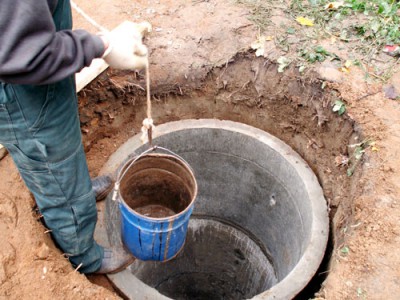 There are two main approaches to reinforcing a well with concrete rings. First way applicable when the waters are shallow, approximately at the level of 5-8 meters. In this case, the first ring is installed in the place of the future well so that it is several centimeters higher than the ground level, and then the remaining soil is excavated from under it: soft soil is first removed from the middle of the well, hard - along its perimeter. When the first ring sinks underground, a second ring is placed on it, and the procedure is repeated. It is very important at this moment to make sure that the first three rings are absolutely vertical, which is checked by the level. Further, the whole process is repeated until the desired depth of the well is reached, and the rings are fastened with brackets in three places and concreted. At the same time, it’s better not to work alone: one person will fill the bucket with earth, and the second will raise filled buckets on the surface. It must be borne in mind that excavation must be carried out so that the rings do not warp, but retain their flat position. When calculating the number of rings needed, it’s easy to make a mistake, so it’s better to buy one or two more than you need. When water begins to appear at the bottom, the ring build-up is stopped and the well is left for 12 hours, then the bottom is cleaned again until the water veins become visible. The well is left for a day, covered with a lid - water should accumulate in it. The bottom is equipped with a gravel-crushed stone mixture: first, fine fractions, and then larger.
There are two main approaches to reinforcing a well with concrete rings. First way applicable when the waters are shallow, approximately at the level of 5-8 meters. In this case, the first ring is installed in the place of the future well so that it is several centimeters higher than the ground level, and then the remaining soil is excavated from under it: soft soil is first removed from the middle of the well, hard - along its perimeter. When the first ring sinks underground, a second ring is placed on it, and the procedure is repeated. It is very important at this moment to make sure that the first three rings are absolutely vertical, which is checked by the level. Further, the whole process is repeated until the desired depth of the well is reached, and the rings are fastened with brackets in three places and concreted. At the same time, it’s better not to work alone: one person will fill the bucket with earth, and the second will raise filled buckets on the surface. It must be borne in mind that excavation must be carried out so that the rings do not warp, but retain their flat position. When calculating the number of rings needed, it’s easy to make a mistake, so it’s better to buy one or two more than you need. When water begins to appear at the bottom, the ring build-up is stopped and the well is left for 12 hours, then the bottom is cleaned again until the water veins become visible. The well is left for a day, covered with a lid - water should accumulate in it. The bottom is equipped with a gravel-crushed stone mixture: first, fine fractions, and then larger.
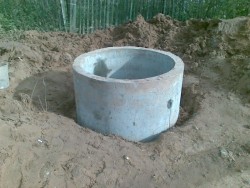 In the shallowest wells you can generally use concrete pipesbut still it’s more often used rings. It is important that they clearly and tightly adjoin each other, do not deviate, which can cause a violation of the tightness of the entire structure. Sometimes when arranging wells use grooved ringsdesigned for septic tanks, but their use is not always advisable: they are more expensive, and not all soil conditions are suitable. In any case, the described method is as safe as possible and is great for self-construction of wells, being one of the most popular.
In the shallowest wells you can generally use concrete pipesbut still it’s more often used rings. It is important that they clearly and tightly adjoin each other, do not deviate, which can cause a violation of the tightness of the entire structure. Sometimes when arranging wells use grooved ringsdesigned for septic tanks, but their use is not always advisable: they are more expensive, and not all soil conditions are suitable. In any case, the described method is as safe as possible and is great for self-construction of wells, being one of the most popular.
If the depth of the aquifer is more than 6-8 meters, then use a slightly different method of arrangement of the well. First, they dig a mine until water reaches, and only then strengthen the walls. If the walls begin to crumble, then go to the first method. If everything goes fine, then as the aquifer reaches the well, concrete rings are lowered into the well, using crane arm or a winch. Often, after lowering the last ring, the well deepens another 1-2 rings according to the first method. This option has its own characteristics: you need to monitor the evenness of the walls of the shaft, and so that their width does not exceed 120-125 cm, and there is always the possibility of collapse of the walls. But this method can boast of speed and convenience.
 Whichever option is chosen, it is important to consider some subtleties. For instance, shaft diameter should be 10 cm larger than the diameter of the concrete ring, and then the gap between the soil and concrete is covered with gravel, and rammed with clay at the top. It is believed that the water level in the well of 1.5 meters is normal - this is approximately 1.5 rings.
Whichever option is chosen, it is important to consider some subtleties. For instance, shaft diameter should be 10 cm larger than the diameter of the concrete ring, and then the gap between the soil and concrete is covered with gravel, and rammed with clay at the top. It is believed that the water level in the well of 1.5 meters is normal - this is approximately 1.5 rings.
In places with a high level of groundwater at the level of the upper three rings it is better to do clay castle. Such waterproofing will protect the water in the well from contaminants along with melt and rainwater.
Our ancestors used to do wood wells: Now this method is considered a special chic, and it is rarely resorted to. The advantage of this well is that many tree species have antiseptic properties, and the water, being in them, is neutralized, acquires a new pleasant aftertaste. In terms of environmental friendliness, a wooden well is much better than a concrete one, but its arrangement costs twice as much, and repair will be expensive. Most often, tree species such as aspen, larch, oak, willow, and birch are used.
Well design
When the main part of the well is ready, you can begin to design it.The upper part, the head, can be seen from almost any end of the site, so it should correspond to the chosen landscape design and be aesthetically attractive. A well house is also necessary in order to protect water from any kind of pollution.
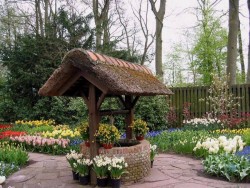 Most often, concrete rings are used in the construction of a well, one of which crowns the entire structure and is located at the very top. Gray and unsightly look concrete can spoil any area, so the easiest way is to paint the well: you can use one color, combine several, create patterns using your own artistic talents or a stencil. There can be no fantasy here, because with the help of paints and brushes you can turn your well into something original Russian or, conversely, Japanese, Mediterranean or Alpine. Instead of paints, you can use any finishing material, and then there are an infinite number of options for arrangement.
Most often, concrete rings are used in the construction of a well, one of which crowns the entire structure and is located at the very top. Gray and unsightly look concrete can spoil any area, so the easiest way is to paint the well: you can use one color, combine several, create patterns using your own artistic talents or a stencil. There can be no fantasy here, because with the help of paints and brushes you can turn your well into something original Russian or, conversely, Japanese, Mediterranean or Alpine. Instead of paints, you can use any finishing material, and then there are an infinite number of options for arrangement.
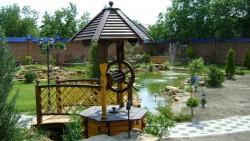 The only rule to follow is harmony of the well with the landscape and other structures on the territory.
The only rule to follow is harmony of the well with the landscape and other structures on the territory.
The design of the well largely depends on what design was chosen. So, Russian well it is equipped with two columns, on which the drum is fixed: a chain with a bucket is attached to it, the winding and unwinding of which are regulated using the handle located on the side. Shaduf more suitable for very shallow wells: here, a crane construction is used to extract a bucket of water. Although now these wells are very unusual in summer cottages, earlier they decorated almost every yard, and you can find a very interesting approach to their design.
You can transform your well as you like, but here are some good examples for inspiration:
- country style. The rustic style mainly uses wood and stone, so it’s great if the house is also built of wood. The cap can be decorated with a log house, the canopy can also be made of wood, but the roof can be made the same as the roof of the house. If the house is decorated in the style of a tower with carved shutters, then the well should receive a shade of fabulousness: it can be decorated with interesting carvings, animal figures, and the head can be made of wood or even brickwork. Around the well in a rustic style, you can plant more bright colors to finally fit it into the created landscape, but you must leave a path to it for easy access;
- East style took root in landscape design, because its simplicity and minimalism impress outdoor recreation. In the culture of eastern countries, the well is given special attention, protecting it from dust, dirt and evil eyes and covering it with a roof. The well can be made of wood or stone, using images of mythical creatures, gods, etc., while the roof will be slightly upturned in the corners. For its arrangement most often use soft tilewhich perfectly takes the given form. Located in the neighborhood rock garden, dry creekjuniper thickets fit perfectly into the landscape;
- sea style. If you strain your imagination a little, you can create a well in any style, for example, in a marine. The head should be trimmed with artificially aged wood, decorated with marine figures, animals, shells, ropes, etc. Instead of a handle, attach a steering wheel, and instead of a bucket, use a beer barrel, and that’s all - the well turns into an original element of landscape design;
- the well can be shaped mills or even a miniature house: so the water will be protected as much as possible from external influences, and the site will be decorated with an interesting element that successfully harmonizes, for example, with barbecue areawhere the presence of fresh water does not hurt;
- modern well. If the cottage is made in a modern style, using plaster, siding, etc., then there is no point in decorating the well in antiquity.In this case, it is better to design it with forging or red brick, and use a sheet as a canopy polycarbonate.
Any remaining construction materials can and should be used in the design of the well, and then its transformation will not take a lot of money. So out of the bag cement you can prepare a solution, coat the head, and freshly cut the brickwork, and then paint - the well in the medieval style is ready. You can also use the remaining ceramic tiles: break them into small pieces and create a mosaic, as a result, you get an interesting eclecticism.
Facing with stone, using a log house, decorating with flowers and stones, different shapes, using buckets of different designs is welcome, and as a result, the most ordinary well can turn into a real masterpiece.
In conclusion
The well is a relatively simple engineering structure, the arrangement of which, nevertheless, requires a thorough and careful approach. It is important to clearly determine where on the site it will be located, for which you can use the services of professionals or folk methods. It is equally important to dig it out and strengthen it, for which concrete rings are most often used, and decoration is the most pleasant process that reveals the creative potential of everyone and turns the well into a unique decoration of the site.






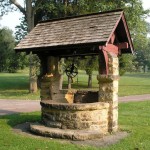

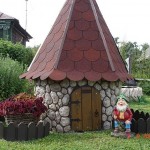
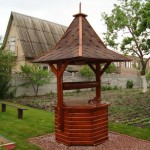
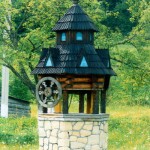

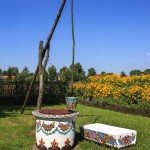

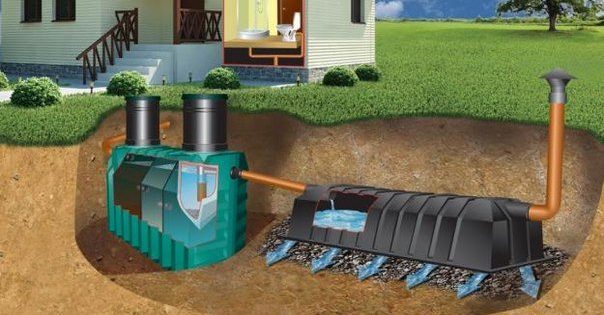
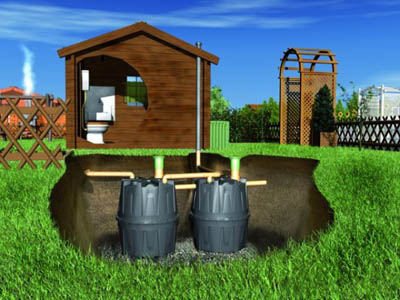

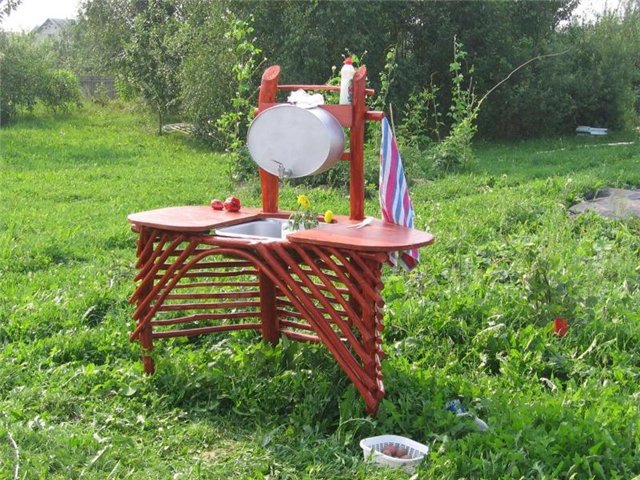




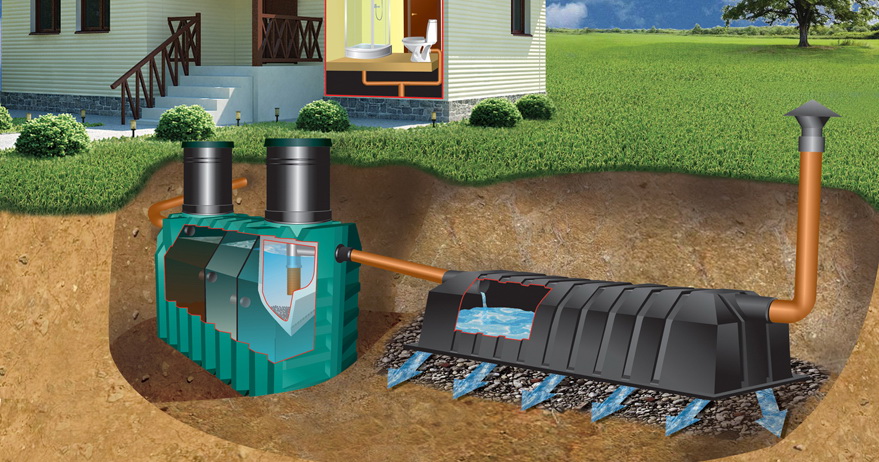
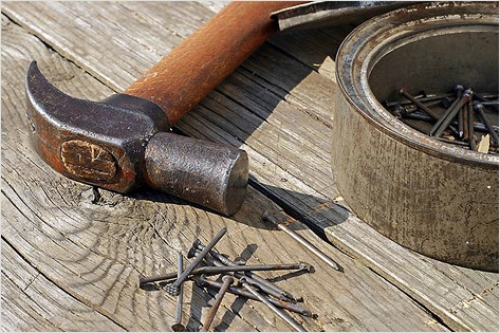
From a log house, the well looks very beautiful.